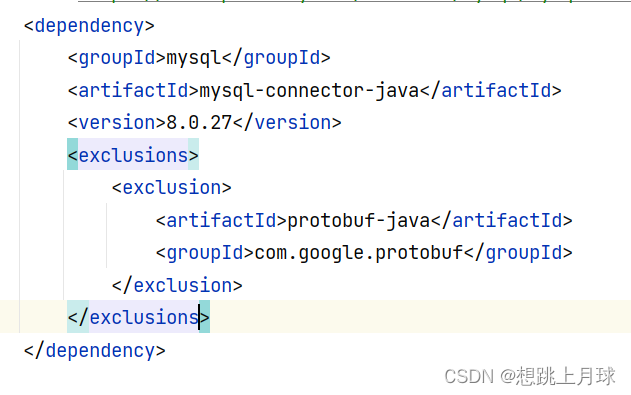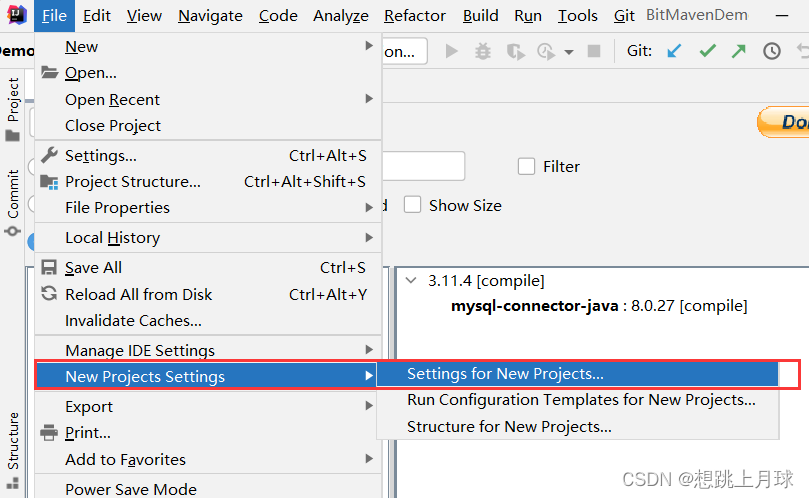-
【SpringBoot】 环境准备
一.SpringBoot准备
1.下载idea
社区版 2021.1 - 2022.1.4
专业版 无要求
2.Maven
是一个工具,和Java没有关系 .
主要功能是项目构建和依赖管理.

上述对应的都是maven命令 .

添加坐标之后,点击刷新,右侧就会载入依赖.
Maven还有依赖传递和依赖排除功能.
依赖传递
比如要使用mysql依赖,mysql所需要的依赖protobuf -java的也会传递过来 .

依赖排除
如果不需要引入的依赖的依赖,可以手动的排除


使用场景: 为了解决冲突 . 如果项目中引入的多个相同但版本不一致的依赖. 就可以使用依赖排除删掉冲突的依赖.
安装插件:maven helper
在idea插件市场搜索安装.

依赖分析

仓库
1.中央仓库 (全球唯一)
仓库地址: Central Repository: (maven.org)
可以通过: https://mvnrepository.com 来查询并下载
2.本地仓库
项目所需要的依赖会先在本地仓库查找.
如果找到了直接获取.
如果找不到 , 本地仓库就会到中央仓库去下载,并且保存到本地仓库. 然后再返回给项目.
查看本地仓库地址

这个地址最好不要包括中文 .
修改本地仓库的地址
1.将原来默认的.m2文件夹一键复制到一个你想到存的地方.
2.点击override . 重新输入路径

3.私服
由于中央仓库的下载速度较慢 , 现在一些企业为了提高下载速度. 有自己的私有服务器 , 一般是企业的. 通常具有一定权限.
有了私服,如果项目需要引入依赖,仍然会先从本地仓库查找.
*如果找到了,就返回.
*如果没找到,就从私服查找.
* 如果从私服找到了,就返回给本地仓库, 再返回给项目.
(公司里只要有一个人下载了,其他人都可以从私服中访问了)
* 如果没找到,私服再去中央仓库下载. 如此一层层返回.
私服的配置
可以使用自己公司的私服

maven国内源有很多 , 这里使用的是阿里的私服.
如果没有settings文件,创建一个settings.xml 文件 , 写入以下内容
- This XML file does not appear to have any style information associated with it. The document tree is shown below.
- <!--
- Licensed to the Apache Software Foundation (ASF) under one
- or more contributor license agreements. See the NOTICE file
- distributed with this work for additional information
- regarding copyright ownership. The ASF licenses this file
- to you under the Apache License, Version 2.0 (the
- "License"); you may not use this file except in compliance
- with the License. You may obtain a copy of the License at
- http://www.apache.org/licenses/LICENSE-2.0
- Unless required by applicable law or agreed to in writing,
- software distributed under the License is distributed on an
- "AS IS" BASIS, WITHOUT WARRANTIES OR CONDITIONS OF ANY
- KIND, either express or implied. See the License for the
- specific language governing permissions and limitations
- under the License.
- -->
- <!--
- | This is the configuration file for Maven. It can be specified at two levels:
- |
- | 1. User Level. This settings.xml file provides configuration for a single user,
- | and is normally provided in ${user.home}/.m2/settings.xml.
- |
- | NOTE: This location can be overridden with the CLI option:
- |
- | -s /path/to/user/settings.xml
- |
- | 2. Global Level. This settings.xml file provides configuration for all Maven
- | users on a machine (assuming they're all using the same Maven
- | installation). It's normally provided in
- | ${maven.conf}/settings.xml.
- |
- | NOTE: This location can be overridden with the CLI option:
- |
- | -gs /path/to/global/settings.xml
- |
- | The sections in this sample file are intended to give you a running start at
- | getting the most out of your Maven installation. Where appropriate, the default
- | values (values used when the setting is not specified) are provided.
- |
- | -->
- <settings xmlns="http://maven.apache.org/SETTINGS/1.2.0" xmlns:xsi="http://www.w3.org/2001/XMLSchema-instance" xsi:schemaLocation="http://maven.apache.org/SETTINGS/1.2.0 https://maven.apache.org/xsd/settings-1.2.0.xsd">
- <!-- localRepository
- | The path to the local repository maven will use to store artifacts.
- |
- | Default: ${user.home}/.m2/repository
- <localRepository>/path/to/local/repo</localRepository>
- -->
- <!-- interactiveMode
- | This will determine whether maven prompts you when it needs input. If set to false,
- | maven will use a sensible default value, perhaps based on some other setting, for
- | the parameter in question.
- |
- | Default: true
- <interactiveMode>true</interactiveMode>
- -->
- <!-- offline
- | Determines whether maven should attempt to connect to the network when executing a build.
- | This will have an effect on artifact downloads, artifact deployment, and others.
- |
- | Default: false
- <offline>false</offline>
- -->
- <!-- pluginGroups
- | This is a list of additional group identifiers that will be searched when resolving plugins by their prefix, i.e.
- | when invoking a command line like "mvn prefix:goal". Maven will automatically add the group identifiers
- | "org.apache.maven.plugins" and "org.codehaus.mojo" if these are not already contained in the list.
- | -->
- <pluginGroups>
- <!-- pluginGroup
- | Specifies a further group identifier to use for plugin lookup.
- <pluginGroup>com.your.plugins</pluginGroup>
- -->
- </pluginGroups>
- <!-- proxies
- | This is a list of proxies which can be used on this machine to connect to the network.
- | Unless otherwise specified (by system property or command-line switch), the first proxy
- | specification in this list marked as active will be used.
- | -->
- <proxies>
- <!-- proxy
- | Specification for one proxy, to be used in connecting to the network.
- |
- <proxy>
- <id>optional</id>
- <active>true</active>
- <protocol>http</protocol>
- <username>proxyuser</username>
- <password>proxypass</password>
- <host>proxy.host.net</host>
- <port>80</port>
- <nonProxyHosts>local.net|some.host.com</nonProxyHosts>
- </proxy>
- -->
- </proxies>
- <!-- servers
- | This is a list of authentication profiles, keyed by the server-id used within the system.
- | Authentication profiles can be used whenever maven must make a connection to a remote server.
- | -->
- <servers>
- <!-- server
- | Specifies the authentication information to use when connecting to a particular server, identified by
- | a unique name within the system (referred to by the 'id' attribute below).
- |
- | NOTE: You should either specify username/password OR privateKey/passphrase, since these pairings are
- | used together.
- |
- <server>
- <id>deploymentRepo</id>
- <username>repouser</username>
- <password>repopwd</password>
- </server>
- -->
- <!-- Another sample, using keys to authenticate.
- <server>
- <id>siteServer</id>
- <privateKey>/path/to/private/key</privateKey>
- <passphrase>optional; leave empty if not used.</passphrase>
- </server>
- -->
- </servers>
- <!-- mirrors
- | This is a list of mirrors to be used in downloading artifacts from remote repositories.
- |
- | It works like this: a POM may declare a repository to use in resolving certain artifacts.
- | However, this repository may have problems with heavy traffic at times, so people have mirrored
- | it to several places.
- |
- | That repository definition will have a unique id, so we can create a mirror reference for that
- | repository, to be used as an alternate download site. The mirror site will be the preferred
- | server for that repository.
- | -->
- <mirrors>
- <!-- mirror
- | Specifies a repository mirror site to use instead of a given repository. The repository that
- | this mirror serves has an ID that matches the mirrorOf element of this mirror. IDs are used
- | for inheritance and direct lookup purposes, and must be unique across the set of mirrors.
- |
- <mirror>
- <id>mirrorId</id>
- <mirrorOf>repositoryId</mirrorOf>
- <name>Human Readable Name for this Mirror.</name>
- <url>http://my.repository.com/repo/path</url>
- </mirror>
- -->
- <mirror>
- <id>aliyunmaven</id>
- <mirrorOf>*</mirrorOf>
- <name>阿里云公共仓库</name>
- <url>https://maven.aliyun.com/repository/public</url>
- </mirror>
- </mirrors>
- <!-- profiles
- | This is a list of profiles which can be activated in a variety of ways, and which can modify
- | the build process. Profiles provided in the settings.xml are intended to provide local machine-
- | specific paths and repository locations which allow the build to work in the local environment.
- |
- | For example, if you have an integration testing plugin - like cactus - that needs to know where
- | your Tomcat instance is installed, you can provide a variable here such that the variable is
- | dereferenced during the build process to configure the cactus plugin.
- |
- | As noted above, profiles can be activated in a variety of ways. One way - the activeProfiles
- | section of this document (settings.xml) - will be discussed later. Another way essentially
- | relies on the detection of a system property, either matching a particular value for the property,
- | or merely testing its existence. Profiles can also be activated by JDK version prefix, where a
- | value of '1.4' might activate a profile when the build is executed on a JDK version of '1.4.2_07'.
- | Finally, the list of active profiles can be specified directly from the command line.
- |
- | NOTE: For profiles defined in the settings.xml, you are restricted to specifying only artifact
- | repositories, plugin repositories, and free-form properties to be used as configuration
- | variables for plugins in the POM.
- |
- | -->
- <profiles>
- <!-- profile
- | Specifies a set of introductions to the build process, to be activated using one or more of the
- | mechanisms described above. For inheritance purposes, and to activate profiles via <activatedProfiles/>
- | or the command line, profiles have to have an ID that is unique.
- |
- | An encouraged best practice for profile identification is to use a consistent naming convention
- | for profiles, such as 'env-dev', 'env-test', 'env-production', 'user-jdcasey', 'user-brett', etc.
- | This will make it more intuitive to understand what the set of introduced profiles is attempting
- | to accomplish, particularly when you only have a list of profile id's for debug.
- |
- | This profile example uses the JDK version to trigger activation, and provides a JDK-specific repo.
jdk-1.4 1.4 jdk14 Repository for JDK 1.4 builds http://www.myhost.com/maven/jdk14 default always - -->
如果有,就修改settings文件.


当然进入企业后,配置公司的私服就可以,不用配置国内源
注意:
配置国内源需要修改两个地方.
1.当前项目
通过settings - > 搜索maven ->修改 User setting file
上述的修改的settings文件只对当前项目有效.
2.为新项目修改.


后续创建的都会使用这个私服. 无需配置.
3.spring项目准备
对于专业版,可以直接创建spring项目
对于社区版,需要安装一个插件 -- Spring Boot Helper (这个插件是收费的)
获取免费的插件
>点击Plugin homepage

>点击versions , 下载这个版本

>回到idea -- > 点击从硬盘安装 --> 选择上一步下载的插件的安装包 ,点击ok -->重启idea

注意:安装之后插件的名字就变了, 如果有更新,一定不要点,否则会变成收费版

二.创建spring项目
file - project - new project - Spring Initializr

>选择Maven
>选择Java8

>选择springboot版本 -- 选择不带snapshot快照(不稳定版本) 的2.*版本

>会自动生成一个启动文件 -- 点击运行启动项目

>编写第一个springboot程序 --- 运行自动生成的启动文件

>直接通过sayhi路径访问.

三.spring和springboot的关系
spring是一个框架 ,为了简化java开发
springboot是基于spring的一个框架,为了简化spring项目的开发.
springboot的诞生就是为了简化spring的开发.
企业中说的spring,一般指的是spring全家桶 .
而我们所说的spring一般是指spring framework .
-
相关阅读:
以太坊合并后展望与机构DeFi的未来
2019Linux系统教程189讲-0203_RHEL8系统基本使用(文件操作)
未来展望:Starday供应链火力全开,为跨境电商再添动力!
Polygon zkEVM网络节点
C#《原CSharp》第四回 人常见岁月更替 却难知人文相继
可观测产品合集
吴恩达机器学习-可选的实验室-正则化成本和梯度(Regularized Cost and Gradient)
深入理解java虚拟机:虚拟机字节码执行引擎(1)
大模型的实践应用1-利用ChatGLM2大模型研发智能自助用药问答系统,远程监控患者的用药情况
SiR-PEG4-NHS ester 硅基罗丹明-四聚乙二醇-活化脂 |SIR荧光探针
- 原文地址:https://blog.csdn.net/weixin_63210321/article/details/134461448
